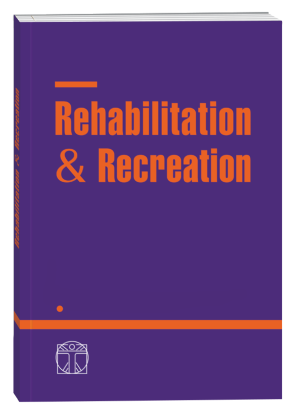ANALYSIS OF SEBT TEST INDICATORS OF MALE REPRESENTATIVES OF KYOKUSHINKAI KARATE AND BOXING IN A SIX-MONTH MEASUREMENT INTERVAL
DOI:
https://doi.org/10.32782/2522-1795.2024.18.4.15Keywords:
Star Excursion Balance Test, boxing, Kyokushinkai karate, martial artsAbstract
Purpose – to compare SEBT indicators, obtained with a six-month interval of measurements in male representatives from Kyokushinkai karate and boxing. Materials and methods. The results of the study were obtained at the Ivan Bobersky Lviv State University of Physical Culture in May and November 2023. Physically healthy, uninjured male qualified boxers (n=8) and Kyokushinkai karate athletes (n=10) aged 18–22 years, who are University students, took part in the collection of experimental material. Research methods: the analysis of literary sources and Internet; measurement of Star Excursion Balance Test indicators; methods of mathematical statistics. Research results. The results confirmed the overall reproducibility of the SEBT test. Differences in SEBT positions in both types of martial arts were unreliable in the absolute majority of indicators, except for position 7 among boxers and position 6 among representatives of Kyokushinkai karate. The indicated individual positions had a significantly better result after six months of training athletes in both types of martial arts after the first measurement. SEBT indicators demonstrate the asymmetric influence of the left-sided combat stance on the motor balance for all boxers, regardless of their training scheme or training program: left leg tend to deteriorate in positions 2, 3, 4, 5, 6, 7, and 8 (position 1 remained unchanged); right pushing leg improved in positions 4, 6, and 7, and slightly decreased in positions 1, 2, 3, and 5 (position 8 remained unchanged); left arm experienced an improvement trend in almost all positions (from 2 to 8); right arm show trends for improvement in positions 2, 3, 4, and 5, and some deterioration in positions 1, 6, 7 and 8. Kyokushinkai karate athletes showed: a trend toward improvement in most of the left leg SEBT measures; most of the SEBT positions of the left arm tend to deteriorate; SEBT indicators of the right leg improved in the “lower” positions 3, 4, and 5, but positions 6 and 8 are slightly worsened; most of the right arm positions during the half-year training period tend to deteriorate. Conclusion. The SEBT technique has high reliability and reproducibility of results over time. The results of SEBT in long time intervals (half a year, for example) can reflect the influence of a certain sport on the amplitude of movements and dynamic balance of athletes.
References
1. Bhanot, K., Kaur, N., Brody, L.T., Bridges, J., Berry, D.C., & Ode, J.J. (2019). Hip and Trunk Muscle Activity During the Star Excursion Balance Test in Healthy Adults. Journal of Sport Rehabilitation, 28(7), 682–691. doi: 10.1123/jsr.2017-0145.
2. Bulow, A., Anderson, J.E., Leiter, J.R., MacDonald, P.B., & Peeler, J. (2019). The modified star excursion balance and y-balance test results differ when assessing physically active healthy adolescent females. International Journal of Sports Physical Therapy, 14(2), 192–203.
3. de la Motte, S., Arnold, B.L., & Ross, S.E. (2015). Trunk-Rotation Differences at Maximal Reach of the Star Excursion Balance Test in Participants With Chronic Ankle Instability. Journal of Athletic Training, 50(4), 358–365. doi: 10.4085/1062-6050-49.3.74.
4. Drouet, N., Bassement, J., & Barbier, F. (2022). The modified star excursion balance test for the detection of the risk of injury in elite handball female players. Journal of sports medicine and therapy, 7: 019–027. doi: 10.29328/journal.jsmt.1001059.
5. Endo, Y., & Miura, M. (2021). Effects of posture and lower limb muscle strength on the results of the Star Excursion Balance Test. The Journal of Physical Therapy Science, Vol. 33, No. 9, 641–645.
6. Gonell, A.C., Romero, J.A., & Soler L.M. (2015). Relationship between the y-balance test scores and soft tissue injury incidence in a soccer team. International Journal of Sports Physical Therapy, 10(7), 955–966.
7. Gribble, P.A., Hertel, J., & Denegar, C.R. (2007). Chronic ankle instability and fatigue create proximal joint alterations during performance of the Star Excursion Balance Test. International Journal of Sports Medicine, 28(3), 236–242.
8. Guan, Yanfei & Bredin, Shannon & Taunton, Jack & Jiang, Qinxian & Wu, Lina & Kaufman, Kai & Wu, Nana & Warburton, Darren (2020). Bilateral difference between lower limbs in children practicing laterally dominant vs. non-laterally dominant sports. European Journal of Sport Science, 21, 1–23. doi: 10.1080/17461391.2020.1814425.
9. Guan, Yanfei & Bredin, Shannon & Jiang, Qinxian & Taunton, Jack & Li, Yongfeng & Wu, Nana & Wu, Lina & Warburton, Darren (2021). The effect of fatigue on asymmetry between lower limbs in functional performances in elite child taekwondo athletes. Journal of Orthopaedic Surgery and Research, 16. doi: 10.1186/s13018-020-02175-7.
10. Jlid, M. & Maffulli, Nicola & Souissi, Nizar & Chelly, Mohamed Souhaiel & Paillard, Thierry (2016). Pre-pubertal males practising Taekwondo exhibit favourable postural and neuromuscular performance. BMC Sports Science, Medicine and Rehabilitation, 8. doi: 10.1186/s13102-016-0040-2.
11. Hertel, J., Braham, R.A., Hale, S.A., & Olmsted-Kramer, L.C. (2006). Simplifying the star excursion balance test: analyses of subjects with and without chronic ankle instability. Journal of Orthopaedic and Sports Physical Therapy, 36 (3), 131–137. doi: 10.2519/jospt.2006.36.3.131.
12. Karagiannakis, D.N., Iatridou, K.I., & Mandalidis, D.G. (2020). Ankle muscles activation and postural stability with Star Excursion Balance Test in healthy individuals. Human Movement Science, 69, 102563.
13. Kindzer, B.M., Nikitenko, S.A., Vyshnevetskyi, S.M., Busol, V.V., & Kukurudziak, I.V. (2024). Porivnyannya pokaznykiv dynamichnoyi rivnovahy za metodykoyu STAR EXCURSION BALANCE TEST sportsmeniv, shcho zaymayutʹsya karate WKF, fekhtuvannyam ta rukopashem Hopak [Comparison of indicators of dynamic balance by the methodology STAR EXCURSION BALANCE TEST of athletes engaged in WKF karate, fencing and Hopak hand-to-hand combat]. Yedynoborstva [Martial arts], 3 (33), 17-29. DOI:10.15391/ed.2024-3.02 [in Ukrainian]
14. Kindzer, B.M., Nikitenko, S.A., & Vyshnevetskyi, S.M. (2024). Pokaznyky dynamichnoi rivnovahy za metodykoiu Star Excursion Balance Test u sportsmeniv riznoi kvalifikatsii z Kiokushyn karate [Indicators of dynamic balance by the method of star excursion balance test in athletes of different qualifications in Kyokushin karate]. Yedynoborstva [Martial arts], 1 (31), 49-57. DOI:10.15391/ed.2024-1.05 [in Ukrainian]
15. Kindzer B.M., Nikitenko S.A. (2023). Vymiriuvannia dynamichnoi rivnovahy u sportsmeniv z Kiokushyn karate, boksu ta aikido za metodykoiu Star Excursion Balance Test (SEBT) [Measurement of dynamic balance in Kyokushin karate, boxing and aikido athletes using the Star Excursion Balance Test (SEBT) method]. Current trends and prospects for the development of physical training and sports of the Armed Forces of Ukraine, law enforcement agencies, rescue and other special services on the path of Euro-Atlantic integration of Ukraine, 415–418 [in Ukrainian]. ISBN 978-617-7187-92-8.
16. Kinzey, S.J., & Armstrong, C.W. (1998). The reliability of the Star-Excursion Test in assessing dynamic balance. Journal of Orthopaedic and Sports Physical Therapy, 27(5), 356–360.
17. Margnes, E., Paillard, T. (2011). Teaching balance for judo practitioners. Ido Movement for Culture. Journal of Martial Arts Anthropology, 11 (1), 42–46.
18.Munro, A.G., & Herrington, L.C. (2010). Between-session reliability of the star excursion balance test. Physical Therapy in Sport, 11, 128–132.
19. Philp, F., Telford, C., Reid, D., & Mccluskey, M. (2019). Establishing normative performance values of modified Star Excursion Balance Test (mSEBT) and Limb 4 Symmetry Index (LSI) scores and their relationship to age in female adolescent footballers. http://dx.doi.org/10.31236/osf.io/k2e5t.
20. Picot, B., Terrier, R., Forestier, N., Fourchet, F., & McKeon, P.O. (2021). The Star Excursion Balance Test: An Update Review and Practical Guidelines. International Journal of Athletic Therapy and Training, 26(6), 285–293.
21. Plisky, P.J., Rauh, M.J., Kaminski, T.W., & Underwood, F.B. (2006). Star Excursion Balance Test as a predictor of lower extremity injury in high school basketball players. Journal of Orthopaedic and Sports Physical Therapy, 36(12), 911–919. doi: 10.2519/jospt.2006.2244.
22. Podrigalo, L., Cynarski, W.J., Rovnaya, O., Volodchenko, O., Halashko, O., Volodchenko, J. (2019). Studying of physical development features of elite athletes of combat sports by means of special indexes. Ido Movement for Culture. Journal of Martial Arts Anthropology, Vol. 19, No. 1, pp. 75–81. doi: 10.14589/ido.19.1.5.
23. Robinson, R.H, & Gribble, P.A. (2008). Kinematic predictors of performance on the Star Excursion Balance Test. Journal of Sport Rehabilitation. 17(4), 347–357.
24. Smith, C.A., Chimera, N.J., & Warren M. (2015). Association of y balance test reach asymmetry and injury in division I athletes. Medicine & Science in Sports & Exercise, 47(1), 136–141. doi: 10.1249/MSS.0000000000000380.
25. Stiffler, M.R., Bell, D.R., Sanfilippo, J.L., Hetzel, S.J., Pickett, K.A., & Heiderscheit, B.C. (2017). Star Excursion Balance Test Anterior Asymmetry is Associated with Injury Status in Division I Collegiate Athletes. Journal of Orthopaedic and Sports Physical Therapy, 47(5), 339–345.
26. Yang, Q.-H., Zhang, Y.-H., Du, S.-H., et al. (2024). Reliability and Validity of the Star Excursion Balance Test for Evaluating Dynamic Balance of Upper Extremities. Sports Health. doi: 10.1177/19417381231221716.
Downloads
Published
How to Cite
Issue
Section
License

This work is licensed under a Creative Commons Attribution-NonCommercial-NoDerivatives 4.0 International License.












